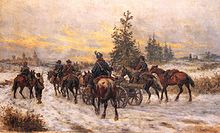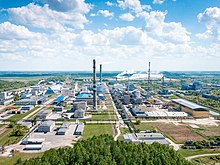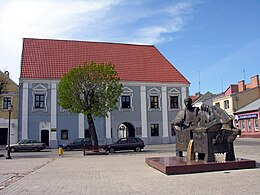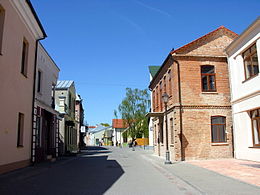|
Kėdainiai
Kėdainiai (Lithuanian: [kʲeːˈdâːɪ.nʲɛɪ̯ˑ] ⓘ) is one of the oldest cities in Lithuania.[2] It is located 45 km (28 mi) north of Lithuania's second largest city Kaunas on the banks of the Nevėžis River.[3] Kėdainiai were first mentioned in the 1372 Livonian Chronicle of Hermann de Wartberge, its population as of 2022[update] was 23,051.[3][4] The Kėdainiai Old Town dates to the 17th century and many of its historical buildings were preserved.[5][6] The town is the administrative centre of the Kėdainiai District Municipality. The geographical centre of the Lithuania is in the nearby village of Ruoščiai in the eldership of Dotnuva. In a ring of five miles, the St Jurgis church is surrounded by smaller villages – Lančiūnava, Kapliai, Labūnava, Josvainiai, Dotnuva, Kalnaberžė. NamesThe city has been known by other names: Kiejdany in Polish, Keidan (קיידאן) in Yiddish,[7][8] and Kedahnen in German. Kėdainiai other alternate forms include Kidan, Kaidan, Keidany, Keydan, Kiedamjzeÿ [9] ("j" /e/), Kuidany, and Kidainiai.[10] History The area was the site of several battles during "The Deluge", the 17th century war between the Polish–Lithuanian Commonwealth and Sweden. In 1655 a short-lived treaty with Sweden, the Union of Kėdainiai, was signed by two members of Radziwiłł family in their Kėdainiai castle. While little remains of the Radziwiłł castle, the crypt of the Calvinist church (1631) houses the family mausoleum, including the tombs of Krzysztof Radziwiłł and his son Janusz. Scottish Protestants arrived in the late 16th and 17th centuries, encouraged by the conversion of Anna Radziwill; the community exerted considerable influence in the city and persisted until the mid-19th century.[11] The grouping of the buildings around the town square still include the imposing homes of merchants known as the "Scottish Houses". These include; the George Anderson House, the John Arnot House, the George Bennet House, the James Gray House, the Steel Property, and the surviving basement of the Alexander Gordon house.[12] A local custom called on all visitors to bring a stone to be used in the town's construction.[5] The 1st Lithuanian National Cavalry Brigade was stationed in the town in 1790.[13] World War II In 1940, the town was invaded and occupied by the Soviet Union. During Operation Barbarossa, Kėdainiai was occupied by the German Army in the summer of 1941. On August 28, 1941, the entire Jewish community of Kėdainiai, a community which had inhabited the area for 500 years, were killed under the direction of German Special Police Battalions, with the aid of the local Lithuanian population. The Jewish population prior to the Holocaust was 3000.[14] Soviet occupation During the Cold War, it was home to Kėdainiai air base, a major Soviet military airlift facility. For many years, Kėdainiai was known for its chemical and food processing industries. The Kėdainiai chemical plant, Lifosa, began operations in January 1963. Publicized as a milestone in the industrialization of Lithuania, it emitted significant quantities of sulfuric acid and was the subject of ecological protests in the 1980s.[15][16] Independent LithuaniaFollowing years of stagnation, old enterprises have come back to life, and new ones have been established, contributing to its status as an economic stronghold.[17] Demographics
TransportationKėdainiai is accessed by Via Baltica highway from Kaunas and Panevėžys, and by rail from Vilnius, Klaipėda and Šiauliai. It is also served by Kaunas International Airport, the second largest airport in Lithuania, located in Karmėlava. Culture  The Kėdainiai Regional Museum, established in 1922, now operates four branches: a Multicultural Centre, the mausoleum of the Dukes Radziwill, the house of Juozas Paukštelis, and the Museum of Wooden Sculptures of V.Ulevičius.[18] Since the city is known as the cucumber capital of Lithuania, it sponsors an annual cucumber festival.[17] In 2013, the band Bastille shot a music video for their single "Things We Lost in the Fire" in the location.[citation needed] A small Polish minority of 329 (0,61%)[19] people live in Kėdainiai district municipality, but only 30 people participate in Stowarzyszenie Polaków Kiejdan (The Kėdainiai Polish Association), the elder people; their cultural activities involve public celebrations of Polish Day of Independence and Day of the Constitution of Third of May, as well as organizing a festival of Polish culture. Since 1994 a School of Polish Language exists.[20][21] Education
SportBasketball club BC Nevėžis, which participate in Lithuanian basketball league. Football club FK Nevėžis, named after the nearby river plays in second-tier league I Lyga. Other football teams include FK Lifosa and FK Nevėžis-2, the reserve team of Nevėžis. Mayors of Kėdainiai
Notable citizens
Twin towns – sister citiesKėdainiai is twinned with:[22] Gallery
See alsoReferences
Wikimedia Commons has media related to Kėdainiai. |
||||||||||||||||||||||||||||||||||||||||||||||||||||||||||||||||||||||||||||||||||||||||||||||||||||||||||||||||||||||||||||||||||||||||||||||||||||||||||||||||||||||||||||||||||||||



















